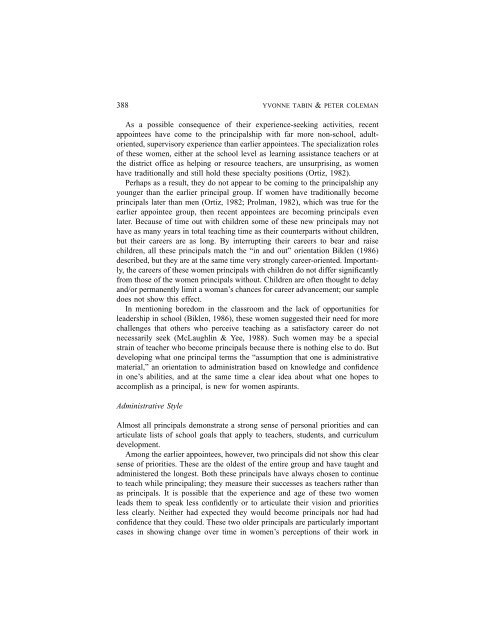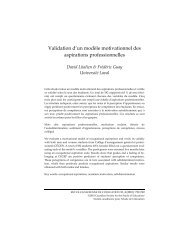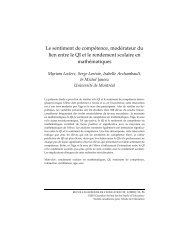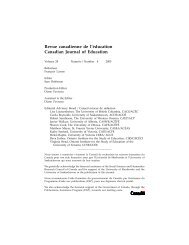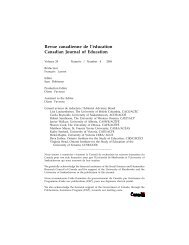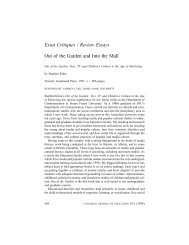Mireille Falardeau et Michel Loranger Le choix de stratégies ... - CSSE
Mireille Falardeau et Michel Loranger Le choix de stratégies ... - CSSE
Mireille Falardeau et Michel Loranger Le choix de stratégies ... - CSSE
You also want an ePaper? Increase the reach of your titles
YUMPU automatically turns print PDFs into web optimized ePapers that Google loves.
388 YVONNE TABIN & PETER COLEMAN<br />
As a possible consequence of their experience-seeking activities, recent<br />
appointees have come to the principalship with far more non-school, adultoriented,<br />
supervisory experience than earlier appointees. The specialization roles<br />
of these women, either at the school level as learning assistance teachers or at<br />
the district office as helping or resource teachers, are unsurprising, as women<br />
have traditionally and still hold these specialty positions (Ortiz, 1982).<br />
Perhaps as a result, they do not appear to be coming to the principalship any<br />
younger than the earlier principal group. If women have traditionally become<br />
principals later than men (Ortiz, 1982; Prolman, 1982), which was true for the<br />
earlier appointee group, then recent appointees are becoming principals even<br />
later. Because of time out with children some of these new principals may not<br />
have as many years in total teaching time as their counterparts without children,<br />
but their careers are as long. By interrupting their careers to bear and raise<br />
children, all these principals match the “in and out” orientation Biklen (1986)<br />
<strong>de</strong>scribed, but they are at the same time very strongly career-oriented. Importantly,<br />
the careers of these women principals with children do not differ significantly<br />
from those of the women principals without. Children are often thought to <strong>de</strong>lay<br />
and/or permanently limit a woman’s chances for career advancement; our sample<br />
does not show this effect.<br />
In mentioning boredom in the classroom and the lack of opportunities for<br />
lea<strong>de</strong>rship in school (Biklen, 1986), these women suggested their need for more<br />
challenges that others who perceive teaching as a satisfactory career do not<br />
necessarily seek (McLaughlin & Yee, 1988). Such women may be a special<br />
strain of teacher who become principals because there is nothing else to do. But<br />
<strong>de</strong>veloping what one principal terms the “assumption that one is administrative<br />
material,” an orientation to administration based on knowledge and confi<strong>de</strong>nce<br />
in one’s abilities, and at the same time a clear i<strong>de</strong>a about what one hopes to<br />
accomplish as a principal, is new for women aspirants.<br />
Administrative Style<br />
Almost all principals <strong>de</strong>monstrate a strong sense of personal priorities and can<br />
articulate lists of school goals that apply to teachers, stu<strong>de</strong>nts, and curriculum<br />
<strong>de</strong>velopment.<br />
Among the earlier appointees, however, two principals did not show this clear<br />
sense of priorities. These are the ol<strong>de</strong>st of the entire group and have taught and<br />
administered the longest. Both these principals have always chosen to continue<br />
to teach while principaling; they measure their successes as teachers rather than<br />
as principals. It is possible that the experience and age of these two women<br />
leads them to speak less confi<strong>de</strong>ntly or to articulate their vision and priorities<br />
less clearly. Neither had expected they would become principals nor had had<br />
confi<strong>de</strong>nce that they could. These two ol<strong>de</strong>r principals are particularly important<br />
cases in showing change over time in women’s perceptions of their work in


